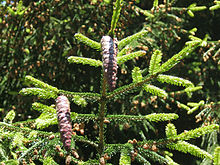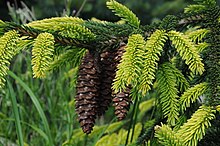Caucasian spruce
| Caucasian spruce | ||||||||||||
|---|---|---|---|---|---|---|---|---|---|---|---|---|

Caucasian spruce ( Picea orientalis ) |
||||||||||||
| Systematics | ||||||||||||
|
||||||||||||
| Scientific name | ||||||||||||
| Picea orientalis | ||||||||||||
| ( L. ) Link |
The Caucasus spruce ( Picea orientalis ), also known as Orient spruce , Oriental spruce and Sapindus spruce , is a species of the spruce genus ( Picea ) in the pine family (Pinaceae). It is used as an ornamental plant with some cultivated forms.
description
The Caucasian spruce is an evergreen tree that grows up to about 33 meters in height, and up to 60 meters in its natural habitat. The trunk can reach a diameter of 1.1 meters. The treetop is narrowly conical; the long leading shoots are often crooked and twisted. The bark is brown, has few cracks and tends to peel off in scales. The bark of the branches is whitish at first, later light brown to orange-brown and hairy. The buds are small and reddish brown. The stiff, square needles rounded at the front are glossy dark green. With a length of 6 to 8 mm, they are the shortest of all spruce species.
The Caucasian spruce is single-sexed ( monoecious ). The male cones are initially dark red, then yellow when dusted and sit on the ends of small twigs. In younger trees, the female cones grow almost exclusively near the summit, while in old trees they are distributed throughout the treetop. The pendulous, ripe cones are about 7 cm tall, curved, pointed, brown and resinous. The seeds are winged.
The number of chromosomes is 2n = 24.
distribution
The Caucasian spruce is native to northern Asia Minor , but especially in the Pontic Mountains there and in the Caucasus . In the mountains it forms dense forests up to an altitude of 2000 meters. Although discovered by European science as early as the 18th century, the Caucasian spruce was only brought to Europe around 1840. Even Joseph Pitton de Tournefort had the kind in 1703 as Abies orientalis folio brevi et tetragono, fructu minimo deorsum inflexo described in his book "corollary Institutionum rei herbariae". Today it is used as an ornamental wood in gardens and parks in the temperate latitudes .
Systematics
This species was in 1763 under the name Pinus orientalis by Linnaeus in Species Plantarum , 2nd Edition, 2, S. 1421 first published . The name Picea orientalis was published in 1847 by Heinrich Friedrich Link in Linnaea , Volume 20, p. 294. Other synonyms for Picea orientalis (L.) Link are: Picea wittmanniana Carrière , Pinus abies var. Orientalis Münchh.
Cultivated forms
The following forms have also been described:
- Picea orientalis forma aureospicata Beissn.
- Picea orientalis forma nana (Carrière) Rehder
- 'Aurea' (Oriental golden spruce): This form, initially described in 1873 as the variety Picea orientalis var. Aurea Ed.Otto , reaches heights of growth of up to 10 meters and has golden-yellow young twigs, which, however, usually turn green in the course of the summer. Ludwig Beissner acquired the variety in 1897 as the form Picea orientalis f. aurea (Ed.Otto) Beissn. classified. This shape is particularly effective from May to June due to the yellow needled branches. Specimens can be found in collections, more rarely in gardens.
Web links
- Characteristics. Retrieved May 12, 2006 (German)
- Picea orientalis in the endangered Red List species the IUCN 2006. Posted by: Conifer Specialist Group, 1998. Retrieved on 12 May, 2006.
- Thomas Meyer: Data sheet with identification key and photos at Flora-de: Flora von Deutschland (old name of the website: Flowers in Swabia )
Individual evidence
- ^ Tropicos. [1]
- ↑ Carl von Linné : Species plantarum exhibentes plantas rite cognitas .. (ed. 2). Volume 2, pages 1421, 1763.
- ↑ Christopher J. Earle, January 20, 2011: Picea orientalis at The Gymnosperm Database . Retrieved January 27, 2011
- ↑ a b Picea orientalis in the Germplasm Resources Information Network (GRIN), USDA , ARS , National Genetic Resources Program. National Germplasm Resources Laboratory, Beltsville, Maryland. Retrieved January 27, 2011.
- ↑ a b Rafaël Govaerts (Ed.): Picea. In: World Checklist of Selected Plant Families (WCSP) - The Board of Trustees of the Royal Botanic Gardens, Kew . Retrieved April 14, 2019.

